
Station Name: WRETHAM & HOCKHAM |
| Date opened: | 18.10.1869 |
| Location: | North side A1075 at the north end of the village |
| Company on opening: | Thetford & Watton Railway |
| Date closed to passengers: | 15.6.1964 |
| Date closed completely: | 15.6.1964 |
| Company on closing: | British Railways (Eastern Region) |
| Present state: | The station buildings, now a private dwelling, have been attractively extended. The house, behind the former station yard, is clearly visible from the A1075 where a small sign reads STATION HOUSE WRETHAM. Alongside the main road there are thick hedges through which it is possible to glimpse part of the former platform partiallyfilled in and laid to lawn. A station name-board is in place, in good condition, painted white on B.R. Eastern Region blue. The outline of the railway can be seen for a short distance to the north but, some way further, a slurry lagoon associated with a pig farm lies along the route. There is no evidence of the level crossing over the A1075 and, on the other side of the now busy road, all sign of the railway’s existence is gone. The trackbed south of the road, where stood the signal box, goods shed and siding, is occupied by a large house and swimming pool. Two hundred yards further south, where the railway ran on a high embankment, Bridge Number 2393 is intact over a lane. Bridge 2392, a little further south, is at the access to Pedar’s Way Long Distance Path. Its span is missing but the brick supports show the bridge number in yellow paint, as on other Great Eastern branches, and a British Railways stencilled code RJS2392, presumably Roudham Junction Swaffham. Heading south the line is lost to agriculture |
| County: | Norfolk |
| OS Grid Ref: | TL926908 |
| Date of visit: | 31.7.2017 |
Notes: Wretham and Hockham Station was located in the tiny hamlet of Stonebridge which lies mid-way between the two villages that gave the station its name. Wretham (pronounced ret-ham) is about a mile away to the south-west and Hockham (pronounced ho-kam) two miles distance north-east of the station site. Hockham was the bigger settlement of the two, offering its residents many more local services. When the station opened it was called Wretham; ‘and Hockham’ not being added until 1 November 1893.
To the north the line was carried on a low embankment. To the south a higher embankment began at the south end of the loop and took the railway over two bridges, numbered 2393 and 2392 in the Great Eastern’s series, before it continued into flat open country parallel to Peddar’s Way, an ancient, possibly pre-Roman, road.
Immediately north of the platform the ‘Home’ (up) and ‘Starter’ (down) signals shared a post on the up side. The up ‘starter’ was located on the station side of the level crossing.
The station closed to passengers, along with all others on the branch, on 15th June 1964. The last trains, composed of a two-car DMU, ran on 12th June, to Thetford at 7.44pm and for Swaffham at 9.33pm. Goods services ceased the same day. A Brief History of the Watton and Swaffham Railway - also known as the Bury and Thetford (Swaffham Branch) Railway
North of Watton a nominally independent company, the Watton and Swaffham Railway was incorporated on 12 July 1869. It would construct a line to reach a west-facing junction with the former Lynn & Dereham Railway, now part of the Great Eastern, close to Swaffham. The line would be worked by the Thetford and Watton company.
Goods services to Swaffham began on 20 September 1875 but it was not until nearly two months later that the supervising authorities were satisfied that the new embankments at Neaton were safe for passenger traffic to commence: it did so on 15 November. Manning Wardle of Leeds supplied the company’s first locomotives after an offer from Robert Fairlie to test his ‘Fairlie Steam Carriage’ was rejected. The Leeds engines were 0-6-0 tanks with three-foot driving wheels. They were joined by a second-hand rebuilt 3ft 6in gauge locomotive whose. The engines were housed in a shed at Watton. In 1876 two larger Sharpe, Stewart & Co 0-4-2 tender engines joined the fleet, presumably because of the motive power needs of the new Swaffham extension. Travelling south from Swaffham there were stations at Holme Hale, Watton, Stow Bedon, Wretham& Hockham and Roudham Junction. Although well provided with sidings for goods traffic the junction had no road access being simply a transfer platform for branch passengers using the Norwich & Brandon Railway’s trains to complete their journey. On 21 July 1879 agreement was reached to lease the line to the Great Eastern Railway for 999 years, commencing on 1st March 1880. In 1897 it was fully absorbed into the Great Eastern Railway and became part of the London & North Eastern Railway at grouping of the nation’s railways on 1 January 1923.
As regards tickets issued for travel, Mr T C F Vollacott wrote a short history of the two railways. He asserted that he did not know whether the Watton and Swaffham company had ever issued its own style of ticket: all that he found bear the name of the working company. Several distinct ticket types were issued: all were standard ‘Edmondson’ size. 1st Class singles were white, 2nd rose, 3rd green and ‘parliamentary’ buff coloured. 3rd class returns were green and buff. Early tickets had serial number and date on the face, right and left sides respectively: later ones had the serial number twice on the face and the date on the back. Today, typically of many agricultural areas crossed by closed railways, some of the former trackbed has been ploughed and is indistinguishable from surrounding fields. However, for some distance north of Watton, the line can be seen as a wooded interruption to extensive fields of arable crops. In the parish of Saham Toney some length of embankment remains in view and, close by, substantial brick-built abutments of an overbridge survive on Long Road at Woodbottom Farm. A little further north a brick overbridge is intact crossing Hale Road. Immediately south of Watton little remains of the line in Thompson Parish except at Griston where the railway crossed a minor road. Here can still be seen the crossing-keeper’s hut and, beside it, a gatepost and the remnants of the personnel gate that was part of the level crossing. ‘The Gate House’, much rebuilt and modernised, still stands beside the crossing. Passing through Thetford Forest between Stow Bedon and Hockham Heath the trackbed is a Permitted Public Path before once more being obliterated by agricultural activity towards the site of Roudham Junction.
Steam-hauled passenger services ceased in 1955 when newly arrived diesel multiple units began work out of Dereham, where the steam engine shed closed at the same time. The 1953 steam-worked timetable shows six through trains with no extra services to or from Watton. Sunday saw two trains, both late in the day, the first activity being at 4.32 pm from Swaffham. Indeed, on weekdays, a traveller might reach Swaffham only as late as 9.44 pm, whilst on Sunday evening it was midnight exactly when the second train reached the town! By 1960 no steam locomotives plied the line on passenger trains and the Sunday service had disappeared. Five Down trains ran throughout, supplemented by an 8.03 am Watton departure to Swaffham (the first up train made a long stop at Watton so may have detached a unit there to form the extra train). One, the 8.25 am from Swaffham, ran through to Ely: there was no corresponding down service.
Tickets for travel from intermediate stations, except at Watton, were issued by the guard. This had happened since Great Eastern Railway days, providing evidence of low numbers of passengers using the line’s smaller stations. Steam locomotives worked out of Swaffham engine shed, a sub-shed of Norwich Thorpe (shed code 32A in BR days). Photographs from the 1950s show passenger work in the hands of D16 4-4-0s and goods trains hauled by various former Great Eastern 0-6-0 types. Latterly Class 03 diesel shunters were to be found working goods turns on the branch. The final timetable in force before closure of the line to passengers shows five through trains in each direction. In addition there was an 8.00 am Watton to Swaffham service. An 8.20 am Thetford to Watton train returned from the market town at 8.49 am after a five minute stop. There was no Sunday service.
To see the other stations on the Watton & Swaffham Railway click on the station name: Roudham Junction, Stow Bedon, Watton, Holme Hale & Swaffham |
Wretham & Hockham Gallery 1: c1900 - February 1964
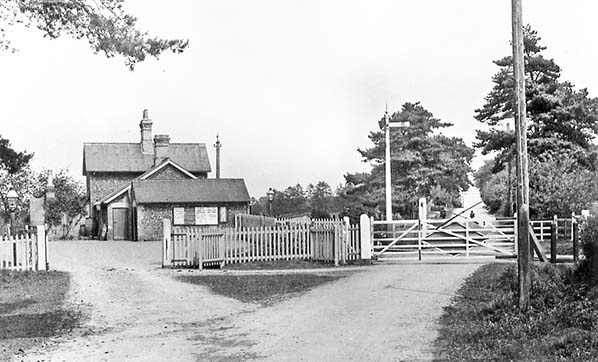
Photo from John Mann collection

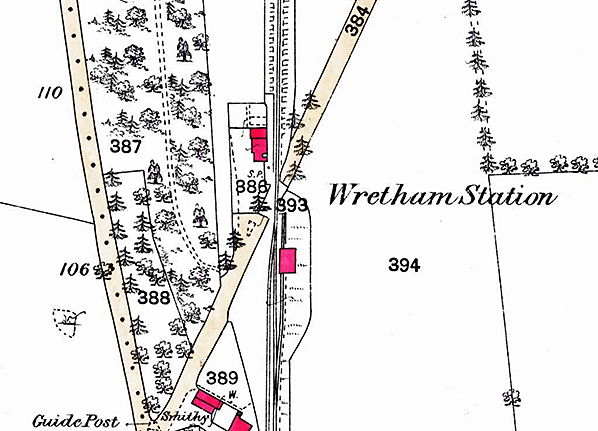
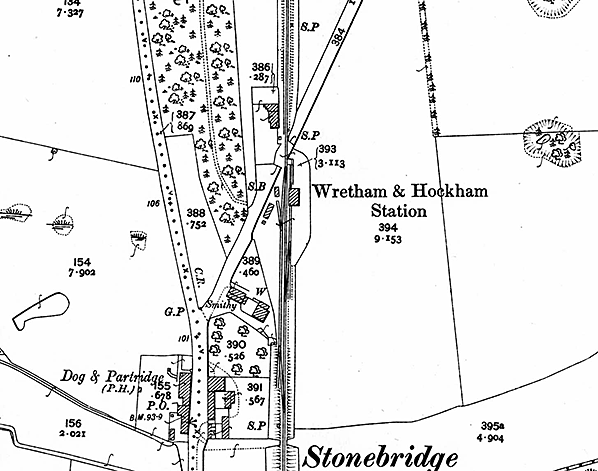
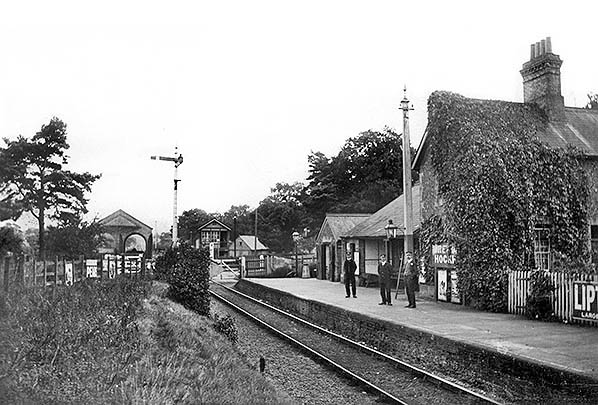 On a postcard view (posted 5.1913) Wretham and Hockham’s station staff pose for the photographer. Looking south across the main road the signal box and goods shed are in view. The loop of track to the south of the signal box, shown on the 1904 25in map, is a siding with buffer-stop in this scene.
On a postcard view (posted 5.1913) Wretham and Hockham’s station staff pose for the photographer. Looking south across the main road the signal box and goods shed are in view. The loop of track to the south of the signal box, shown on the 1904 25in map, is a siding with buffer-stop in this scene.Copyright photo from John Alsop collection
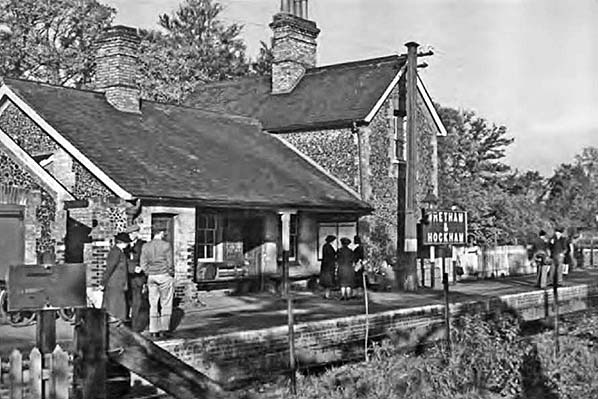
Photo from John Mann collection
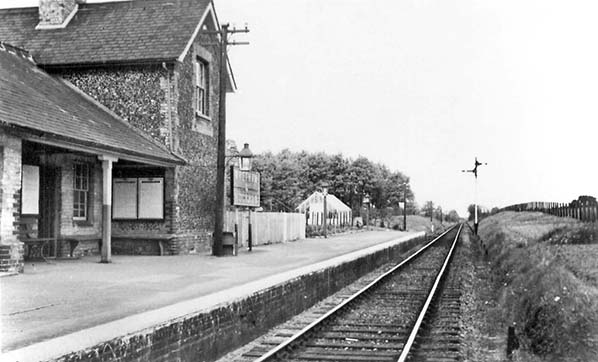
Photo from John Mann collection
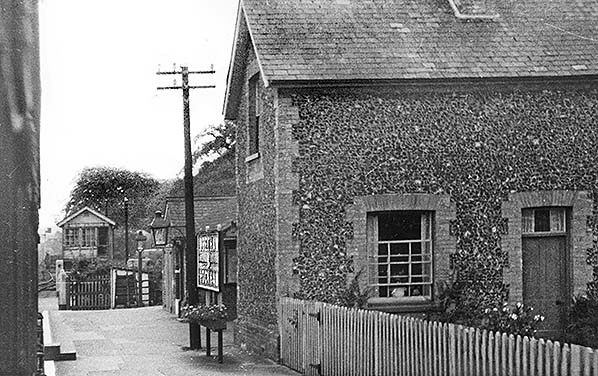
platform in August 1955.
Photo by RM Casserley
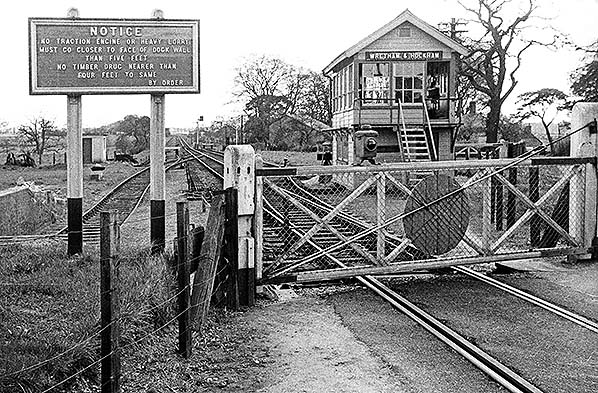
Photo David Pearson
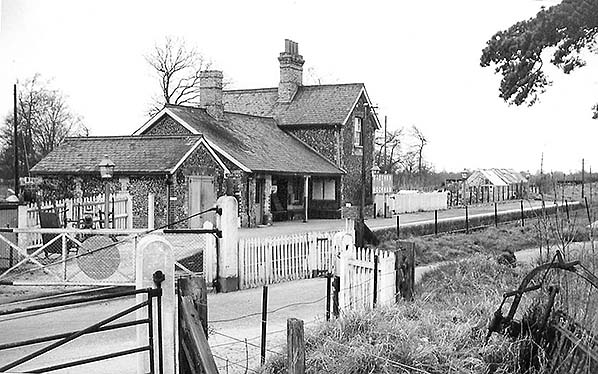
Photo from John Mann collection
Click here for Wretham & Hockham Gallery 2:
June 1964 - July 2017
| Last updated: Monday, 18-Dec-2017 16:53:52 CET |
© 1998-2017 Disused Stations
|

 The station facilities straddled the Thetford to Watton road, now A1075, and were separated by a gated level crossing. At this point on the branch line the railway was running very nearly due south to north. The station’s one platform was directly north of the road on the west (down) side. The signal box and facilities for goods traffic lay south of the crossing. A goods shed was located on the east (up) side of the running line on a siding shunted from the south. At the same place there was a loop of track on the west side, protected at each end by trap-points. Here there appears to have been a yard accessed directly off the roadside. It lay behind a smithy which still stands today as a house: in 1883 Henry Edwards was the blacksmith.
The station facilities straddled the Thetford to Watton road, now A1075, and were separated by a gated level crossing. At this point on the branch line the railway was running very nearly due south to north. The station’s one platform was directly north of the road on the west (down) side. The signal box and facilities for goods traffic lay south of the crossing. A goods shed was located on the east (up) side of the running line on a siding shunted from the south. At the same place there was a loop of track on the west side, protected at each end by trap-points. Here there appears to have been a yard accessed directly off the roadside. It lay behind a smithy which still stands today as a house: in 1883 Henry Edwards was the blacksmith.  The station buildings followed a similar pattern to other stations on the Thetford and Watton Railway. A large station house and a small shed opening onto the platform each had their roof lines at right-angles to the platform edge. They were linked by a single-storey building that incorporated small sheltered areas on both platform and station yard sides. This building had its roof ridge parallel to the running lines. Each of the bigger structures had imposing chimneys built of brick over slate roofing. At Wretham and Hockham all three parts of the station were constructed of Norfolk flint. The platform was lit by several oil-lamps.
The station buildings followed a similar pattern to other stations on the Thetford and Watton Railway. A large station house and a small shed opening onto the platform each had their roof lines at right-angles to the platform edge. They were linked by a single-storey building that incorporated small sheltered areas on both platform and station yard sides. This building had its roof ridge parallel to the running lines. Each of the bigger structures had imposing chimneys built of brick over slate roofing. At Wretham and Hockham all three parts of the station were constructed of Norfolk flint. The platform was lit by several oil-lamps. 
 In William White's History, Gazetteer, and Directory of Norfolk for 1883 Thomas Bedford was recorded as Station Master. In Kelly’s for 1896 Walter Henry Overy had taken over the task. The Dog and Partridge Inn, about fifty yards from the station and still open in 2017, was run by Frederick Hudson who was also a farmer and cattle dealer.
In William White's History, Gazetteer, and Directory of Norfolk for 1883 Thomas Bedford was recorded as Station Master. In Kelly’s for 1896 Walter Henry Overy had taken over the task. The Dog and Partridge Inn, about fifty yards from the station and still open in 2017, was run by Frederick Hudson who was also a farmer and cattle dealer.
 At Roudham the junction faced west towards Thetford. The railway’s nine-mile route from the main line at Roudham Junction across an agricultural and partly wooded landscape was easy terrain, required no significant earthworks or gradients and the railway was opened through to Watton on 18 October 1869. It was a further six years before completion of the nine and a half-mile extension northwards to Swaffham: it is said that the extension cost £72,000 to build. Its construction was delayed and complicated due to difficult land at Neaton, just north of Watton. Here a deep depression had to be filled and compacted and an embankment formed to carry the railway. Earth was extracted from a pit beside the route. Part of the extraction site was flooded and became known locally as
At Roudham the junction faced west towards Thetford. The railway’s nine-mile route from the main line at Roudham Junction across an agricultural and partly wooded landscape was easy terrain, required no significant earthworks or gradients and the railway was opened through to Watton on 18 October 1869. It was a further six years before completion of the nine and a half-mile extension northwards to Swaffham: it is said that the extension cost £72,000 to build. Its construction was delayed and complicated due to difficult land at Neaton, just north of Watton. Here a deep depression had to be filled and compacted and an embankment formed to carry the railway. Earth was extracted from a pit beside the route. Part of the extraction site was flooded and became known locally as  Although not a large town, Watton has a long-established market having received its Charter in 1204 allowing a market to be held on Wednesdays. The coming of the railway invigorated business in the town and two large monthly cattle markets brought livestock traffic to the railway. Like many of East Anglia’s railways it was agriculture that generated much of the goods traffic. From Watton went poultry, butter, milk and eggs, principally to Cambridge and London markets. Coal and other produce not locally available arrived by train.
Although not a large town, Watton has a long-established market having received its Charter in 1204 allowing a market to be held on Wednesdays. The coming of the railway invigorated business in the town and two large monthly cattle markets brought livestock traffic to the railway. Like many of East Anglia’s railways it was agriculture that generated much of the goods traffic. From Watton went poultry, butter, milk and eggs, principally to Cambridge and London markets. Coal and other produce not locally available arrived by train..gif) Throughout its life there was little change in the number and frequency of passenger trains on the branch. The 1906 timetable shows five southbound weekday (up) through trains and four down. There was no Sunday service. Additionally, at 8.30 am, a non-stop train left Thetford and terminated at Watton. On Wednesday only market-goers bound for Watton were catered for by a 1.20 pm departure from Swaffham: it set out on its twenty-minute return journey at 3.15 pm.
Throughout its life there was little change in the number and frequency of passenger trains on the branch. The 1906 timetable shows five southbound weekday (up) through trains and four down. There was no Sunday service. Additionally, at 8.30 am, a non-stop train left Thetford and terminated at Watton. On Wednesday only market-goers bound for Watton were catered for by a 1.20 pm departure from Swaffham: it set out on its twenty-minute return journey at 3.15 pm. 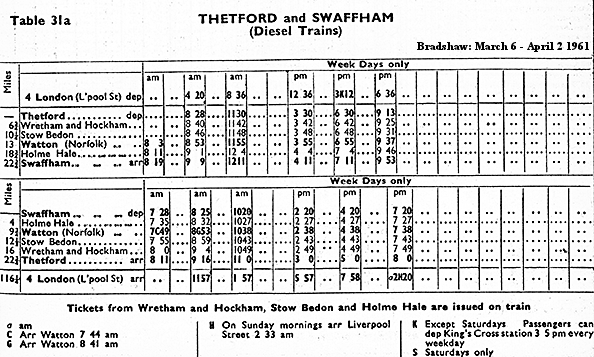
 The British Railways Board published Dr Richard Beeching’s report The Reshaping of Britain’s Railways on 27 March 1963. By 20 September of that year the Eastern Region had published proposals to close the Thetford to Watton Branch, allowing two months for consultation and objections. With what may seem like undue haste Ernest Marples, Minister of Transport, received a report on 9 January 1965 and gave his consent to closure on 27 February. The line closed on 15 June 1964. The last passenger service, the 9.21 pm from Thetford to Swaffham, ran on 12th June 1964 and was formed of a two-car diesel multiple unit with driver David Grant of Dereham in charge, carrying, it was reported locally, seventy passengers. Roudham Junction to Watton closed completely. The line north of Watton closed finally on 19 April 1965. The last train carried in coal and took away a sugar-beet harvest. Rails were removed soon after.
The British Railways Board published Dr Richard Beeching’s report The Reshaping of Britain’s Railways on 27 March 1963. By 20 September of that year the Eastern Region had published proposals to close the Thetford to Watton Branch, allowing two months for consultation and objections. With what may seem like undue haste Ernest Marples, Minister of Transport, received a report on 9 January 1965 and gave his consent to closure on 27 February. The line closed on 15 June 1964. The last passenger service, the 9.21 pm from Thetford to Swaffham, ran on 12th June 1964 and was formed of a two-car diesel multiple unit with driver David Grant of Dereham in charge, carrying, it was reported locally, seventy passengers. Roudham Junction to Watton closed completely. The line north of Watton closed finally on 19 April 1965. The last train carried in coal and took away a sugar-beet harvest. Rails were removed soon after..gif)


 Home Page
Home Page